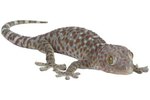
Despite their superficial resemblance, lizards and salamanders are very different types of animals with vastly different lifestyles. While many salamanders and lizards require similar cages and diets, their environmental and thermal needs are very different. Many lizards need high temperatures and basking lamps, but most salamanders fare best at room temperature or lower.
Keeping Cool and Damp
Whereas temperature is one of the most important aspects of reptilian biology, humidity and water relations are among the most important aspects of salamander biology. Salamanders typically inhabit leaf litter, streams and subterranean tunnels, all of which remain relatively cool year-round. During periods of excessive heat, salamanders often become inactive or seek out cooler microhabitats. Whereas rainfall often causes lizards to take shelter and become inactive, the increased humidity allows salamanders to be active on the surface, without fear of desiccation.
Target Temperatures
The thermal needs of salamanders vary greatly, and it is important to research the needs of your particular species. As a rough guideline, most North American species prefer temperatures between 50 and 70 degrees Fahrenheit, though some tropical species prefer very slightly warmer temperatures. The thermal maximum -- the temperature at which death usually occurs -- is surprisingly low for many salamanders; always strive to keep them below 75 degrees Fahrenheit.
Proper Heating When Necessary
If your species requires supplemental heat, it is best to provide heat from below, by using a heat pad. When doing so, only use a small heating pad, placed under a small portion of the cage. By only heating part of the cage, you are providing your salamander with a place to escape the heat, should he so desire. Always measure cage temperatures with a quality digital thermometer to keep your pet comfortable.
Lukewarm Illumination
Salamanders do not require supplemental lighting of any kind, and will thrive with ambient light alone. Many salamanders are nocturnal, and will not be active when the lights are on anyway. If you do wish to light the cage, use fluorescent light bulbs, which produce relatively little heat, rather than incandescent “heat lamps.” If you intend on breeding your salamanders, be sure to keep the room lights on a cycle which mimics their natural photoperiod.
Chilling Out
Often, salamander keepers struggle to keep their habitats cool enough, rather than warm enough. A variety of techniques and strategies can help address this issue -- one of the simplest is to increase the rate of evaporation. When water evaporates from your salamander’s tank, it lowers the temperature inside. By increasing the ventilation -- and therefore evaporation -- through the use of screened lids and fans, you can keep your salamander’s cage cooler and more comfortable. Whenever you use evaporative cooling, you must add more water to the cage to offset the losses.
References
- Journal of Thermal Biology: Temperature-Mediated Characteristics of the Dusky Salamander (Desmognathus Fuscus) of Southern Appalacia
- ReptileChannel.com: Spotted Salamander Care Sheet
- That Reptile Blog: Newts as Pets-- An Introduction to Their Care and Feeding
- Doctors Foster and Smith: FAQs: Newts and Salamanders
Resources
Photo Credits
-
Jupiterimages/Photos.com/Getty Images




